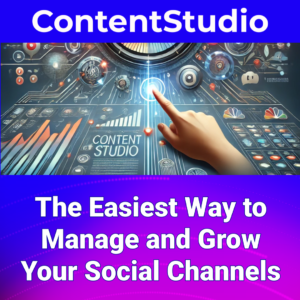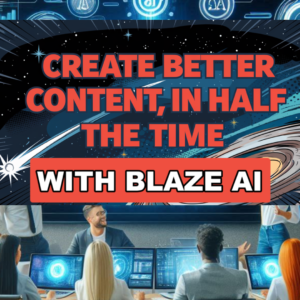In the modern, fast-paced digital era, artificial intelligence (AI) serves a purpose beyond being a mere tool. This transformation is fundamentally altering our perception of creativity and innovation. AI is transitioning from a mere assistant to becoming a collaborator, opening up new avenues for creative endeavors. This particular shift holds great significance for marketing professionals and business owners who are looking to leverage AI in order to enhance their strategies.
AI’s potential as a creative partner comes from its ability to process large amounts of data quickly and efficiently. It can analyze trends, predict outcomes, and generate ideas that might not be obvious to humans. This ability allows marketers to explore new paths and create innovative campaigns that connect with their audience.
However, the real power of AI as a creative partner shows when it’s combined with human creativity, intuition, and playfulness. While AI can do tasks precisely, it’s the human element that shapes the vision and direction of creative projects. By working together, humans and AI can achieve amazing results that neither could do alone.
The Human Element in AI Collaboration
Working together with AI is a dynamic process that needs a balance of skills and perspectives. Human creativity, intuition, and playfulness are key drivers of innovation, providing the spark that starts new ideas and possibilities. AI, on the other hand, is great at doing tasks, analyzing data, and generating insights.
Beyond Tools: AI as a Thought Partner
AI’s role as a thought partner goes beyond just being a tool. It can help in brainstorming sessions, offering suggestions and insights that might not have been considered otherwise. By working with AI in a collaborative way, marketers can unlock new levels of creativity and innovation.
For example, AI can analyze consumer behavior and preferences, providing valuable insights that inform marketing strategies. It can also generate content ideas, suggest improvements, and even create personalized marketing messages that connect with individual customers. This level of collaboration allows marketers to create campaigns that are both innovative and effective.
Shaping Vision: The Human Touch
While AI can do tasks precisely, it’s the human touch that shapes the vision and direction of creative projects. Humans bring a unique perspective, intuition, and emotional intelligence that AI can’t replicate. This human element is essential in guiding AI’s tasks and making sure the final product matches the desired vision.
In marketing, this means that while AI can generate content and analyze data, it’s the marketer’s job to ensure that the message matches the brand’s values and connects with the target audience. By combining AI’s abilities with human creativity and intuition, marketers can create campaigns that are both innovative and impactful.
The Concept of Prompt Minimalism
The rise of large language models (LLMs) has introduced the idea of “prompt minimalism,” where users give brief instructions for AI to deliver well-crafted responses. This trend makes things more efficient but may also limit creative exploration in AI interactions.
Efficiency vs. Exploration
Prompt minimalism offers simplicity and speed, allowing marketers to quickly generate content and insights. However, this approach can also reduce the chance for creative exploration. By relying only on minimal prompts, marketers may miss out on the potential for deeper collaboration and innovation.
To balance efficiency and exploration, marketers can try different types of prompts. By giving more detailed instructions and engaging in a back-and-forth exchange with AI, marketers can foster deeper collaboration and unlock new levels of creativity.
Iterative Prompting for Deeper Collaboration
Iterative prompting involves a dynamic interaction between humans and AI, where both parties contribute to the creative process. This approach encourages a back-and-forth exchange of ideas, allowing for richer, more innovative outcomes.
In marketing, iterative prompting can be used to refine content, generate new ideas, and explore different strategies. By engaging in a collaborative dialogue with AI, marketers can develop campaigns that are both creative and effective.
Unlocking AI’s Creative Potential
To fully unlock AI’s creative potential, it’s important to balance simple and complex prompts. This balance allows for a harmonious synergy between human creativity and AI capabilities.
The Art of Prompting
Crafting prompts that maximize AI’s creative output is an art in itself. By experimenting with different types of prompts, marketers can discover new ways to engage with AI and enhance its creative capabilities.
For example, marketers can use open-ended prompts to encourage AI to generate a wide range of ideas. They can also use specific prompts to guide AI’s focus and ensure that the generated content matches the desired vision. By mastering the art of prompting, marketers can unlock AI’s full creative potential and develop innovative campaigns that connect with their audience.
Enhancing Human-AI Synergy
Achieving a harmonious balance between human creativity and AI capabilities is crucial for successful collaboration. By leveraging the strengths of both humans and AI, marketers can create powerful and innovative outcomes.
In marketing, this means combining AI’s data analysis and content generation capabilities with human creativity and intuition. By working together, humans and AI can develop campaigns that are both innovative and effective, driving business success and enhancing brand reputation.
The Future of AI Innovation
The future of AI innovation is not just about advancements in technology but also about how we use these tools. By embracing the messiness of the creative process and leaning into human strengths, the partnership between humans and AI can become more powerful and productive.
Beyond Technological Advancements
While technological advancements are important, the true potential of AI lies in how we use these tools. By focusing on creative collaboration, marketers can unlock new possibilities for innovation and drive business success.
In the future, AI will continue to evolve, offering new capabilities and opportunities for collaboration. By staying ahead of the curve and embracing new technologies, marketers can maintain a competitive edge and achieve their business goals.
Embracing Creative Messiness
The creative process is often messy, but this messiness can lead to unexpected and innovative outcomes. By embracing this aspect of creativity, marketers can enhance their collaboration with AI and achieve greater success.
In marketing, this means being open to new ideas, experimenting with different strategies, and embracing the unexpected. By working together, humans and AI can develop campaigns that are both innovative and effective, driving business success and enhancing brand reputation.
Practical Applications for Marketing Professionals
For marketing professionals and business owners, AI offers exciting opportunities to enhance their strategies and stay ahead in the rapidly evolving marketing landscape.
Leveraging AI for Content Creation
AI can be used to create written, audio, and video content effectively and at scale. By leveraging AI’s capabilities, marketing professionals can produce high-quality content that resonates with their audience.
For example, AI can generate blog posts, social media content, and email marketing campaigns that are tailored to individual customers. It can also create personalized video content that engages and entertains viewers. By using AI to create content, marketers can save time and resources while delivering impactful messages that drive business success.
Staying Ahead in the Marketing Landscape
In the competitive marketing industry, staying ahead of the curve is essential. By using AI to gain insights and make data-driven decisions, marketing professionals can maintain a competitive edge and achieve their business goals.
AI can analyze consumer behavior, identify trends, and predict outcomes, providing valuable insights that inform marketing strategies. By leveraging these insights, marketers can develop campaigns that are both innovative and effective, driving business success and enhancing brand reputation.














